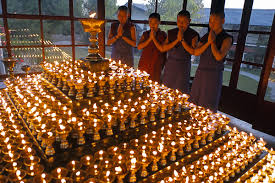A Buddhist Guide to Incense - The Traditional Use of Incense in Buddhist Practice
Burning incense is an ancient practice found in all schools of Buddhism. Certainly one can realize enlightenment without it. But if you practice formally with other Buddhists, then you are going to encounter incense.
The History of Incense and Buddhism
The use of incense appears to stretch back to the beginning of human history. Incense is mentioned frequently in the Pali Canon, scriptures that date to the life of the Buddha. Along with flowers, food, drink, and even garments, incense was a common offering made to a revered person, as a sign of respect.
While offering incense at an altar is arguably a universal Buddhist ritual, Buddhists don't always agree why. Most basically, incense is thought to purify the space, whether that space is a meditation hall or your own room. Incense can create a tranquil mood. In some schools, incense may have a particular symbolic meaning. Three sticks burned together might signify the Three Treasures, for example -- the Buddha, the dharma, and the sangha.
Whatever the symbolic meaning, making an incense offering before your daily chanting or meditation practice is a good way to focus your attention and create a pure space for your practice.
Types of Incense
Westerners probably are most familiar with stick or cone incense. You'll find stick incense is much more commonly used in a Buddhist temple. There is also a kind of loose incense that is burned by dropping grains of incense onto hot charcoal.
There are two kinds of stick incense: Coreless or "solid" incense and incense with a bamboo core. The coreless incense is more appropriate for Buddhism because it burns completely away. But the bamboo core incense is commonly used also.
There are many other kinds of incense. In some Asian temples, huge coils of burning incense are suspending from the ceilings. However, here we're just going to discuss stick and loose incense.
Western "dharma supply" stores and catalogs usually offer Japanese, Tibetan and sometimes Indian incense. Fragrances and quality can vary wildly. But in general, If you want a more subtle fragrance with less smoke, go with Japanese. If you want a more assertive incense, go with Tibetan.
Let's say you've set up a home altar, and you want to offer incense to the Buddha. Usually, you would light the candle first, then light the incense from the candle. A standard practice is to bow to the Buddha image with your palms together, then (leaving one hand in the palms-together position) light one end of the incense.
So there you are with a flaming incense stick. In Asia, it's considered bad form to blow out the flame; it's like spitting on the incense, which is disrespectful. Sometimes people wave the incense sticks to put them out or fan the flames with their hands. If you are worried about flying sparks, hold the sticks straight up and then jerk them down, quickly. Burning incense sticks can get hot enough to cause blisters, so take care.
Now, where do you put the stick? Planting the unlit end into an incense bowl is a common choice. Any ceramic or metal bowl will do. Zen temple incense bowls are filled with old incense ash, accumulated through the years. If you don't have accumulated incense ash, you can try fine, clean sand. you could also fill incense bowls with uncooked rice, but beware of attracting mice.
Note that the "ash catcher" or "boat" incense burners you might find in the dharma store are intended for use with incense with a bamboo core and might not work with solid incense.
Note also that stick incense is used as a meditation timer. Some manufacturers will provide estimated burn times on the box.
You might encounter loose incense in a temple. In this case, you might see in front of you a small brazier, or a simple box filled with ash or sand, containing a piece of burning charcoal. And next to it will be a container full of little incense pellets.
To make an offering, bow with palms together. Leaving the left hand in palms-together position, take a pinch of loose incense with the fingers of your right hand. Touch the pinch of incense to your forehead, then drop the pellets onto of the burning charcoal. There will be a poof of fragrant smoke. Bow again before moving on.
And that's it. Practices vary from one school to another, so if you are in a temple watch what other people do.
Safety Warnings
Do practice fire safety precautions with your candles and incense. Don't leave either unattended, especially if you have small children or curious cats.
There are studies saying that breathing incense smoke increases cancer risk, although it's much less risky than smoking. Still, you probably shouldn't be breathing incense all day long.
If even mild incense irritates you, here is an alternative — offer dried flower petals instead of incense, simply placing the petals in a bowl in front of the Buddha. Once the offering bowl is full, the petals can be used as compost.
[[1]]
